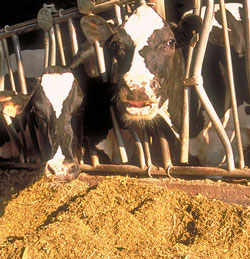
Distillers grains are a by-product of the ethanol process and a high source of protein for cattle.
The removal of oil from distillers grains, as another way to add revenue to ethanol production, has become near universal in the ethanol industry.
The change has raised questions about the impact on the distillers grains product for beef producers — the main consumers of distillers grains. Researchers with the University of Minnesota Beef Team have stepped up to look at the question and have found solid evidence that reduced-fat distillers grains perform just as well in terms of weight gain and other performance indicators. A further question as to the fatty acid profile of beef fed different amounts of oil offers an interesting suggestion that reduced-fat could well improve meat’s resistance to oxidation — a key factor with products that involve grinding or processing like hamburger, bologna or sausage.
“For animals fed full-fat distillers at a 20 percent inclusion rate, or reduced-fat at 20 percent inclusion, they gained at the same rate, and converted at the same rate, without any significant difference,” said Alfredo diCostanzo, professor of animal science at the University of Minnesota and member of the research team. “Feedlot operators can leave their distillers at the same inclusion level and expect the performance to remain the same.”
DiCostanzo believes strongly in the value of this kind of research. In asking beef producers how they make use of this kind of information, they tell him that each data point adds incrementally to the base of information producers use in their day-to-day operations.
“One of the biggest reasons to do this study is the initial impact, how they perceive distillers,” DiCostanzo said. “They may say to each other, ‘Oh they took away the fat. What is this going to do to my performance?’ And so it takes somebody, or the universities in this case. We’ll do the comparisons and you go on doing your own thing. And we’ll come back to you and report whether it’s a real big issue or it isn’t. As we distribute this information to the user, the user takes it in immediately and it becomes a knowledge data base in their head and it permeates the entire industry. It isn’t just the grower and producer, it will also be the consultant, the adviser that is working with them — they all make use of this information. They are in Minnesota and they run off to consult with someone in Iowa and they carry that information to Iowa as well, so it pretty much becomes a standard of the industry in this way.”
The study compared reduced-fat and full-fat distillers (reduced-fat distillers is seven to 10 percent fat, while full fat is 10 to 13 percent oil). A control group took a ration of corn and soybean meal. A fourth ration used the reduced-fat distillers, but increased the inclusion rate to 46 percent in order to equal the fat in the full-fat distillers fed at a 20 percent inclusion rate — 5.1 percent fat by volume. The researchers fed 46 Jersey and Jersey/Limousin-cross using a Calan feeding system, and finished them to a 1,500-pound live weight. A commercial beef facility in Nebraska processed the cattle and took carcass measurements and tested two wholesale cuts from the chuck and loin.
The University of Minnesota meat lab collected strip loins and shoulder clods for further analysis and looked at the effect of fat levels in three meat products – fresh steaks, ground beef and a cooked beef product (bologna).
“What we think is that at the inclusion rate of 20 percent, reduced-fat has the same energy value as full-fat distillers, and part of the reason is that the nutrients in the reduced fat, such as fiber and protein, are able to make up for the reduction in fat content,” DiCostanzo said. “Though the fat is reduced, you get back more fiber, which is highly digestible. Sometimes we underestimate the value of how digestible the fiber in distillers grains is. When we say ‘fiber’ in the cow world, in the feedlot world, we are always thinking fiber is negative, it’s anti-growth, etc…But in the case of distillers, it’s such a fine fiber and such a highly digestible fiber that it does contribute a significant amount of energy.”
The meat lab measured aspects of shelf-life like oxidation/rancidity, and how the meat maintained its color over time. Tenderness was tested. They made initial tests of fatty acids using gas chromatography. DiCostanzo feels further research into fatty acid profiles would likely offer interesting results. The fatty acid levels directly impact the rate of oxidation/rancidity — higher oils in the feed can have a mild softening and oxidizing affect on the meat, researchers hypothesize.
“We like the fact that things can stay as they are in the beef fat, because we are going to grind it for ground beef, for bologna, for other products like sausages. So we want that product to stay nice, and not get rancid,” DiCostanzo said. “And you can imagine, as you grind the product, it catches more oxygen in it and it might make the process of rancidity occur faster. There’s a potential that reduced-fat distillers grains at 20 percent inclusion could have way better beef than when fed full-fat distillers at 20 percent inclusion. So that’s an area where we might want to devote further research.”

